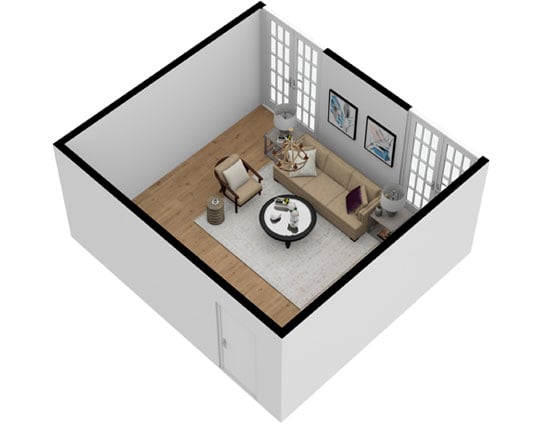Unleash Your Inner Developer With Room Designer Insights
Area Designer Insights use a detailed overview to recognizing the nuances of color psychology, furniture placement, lighting techniques, and the art of mixing patterns and textures. By delving into these understandings, individuals can open the possible to produce rooms that not only show their distinct design but likewise stimulate a feeling of consistency and convenience.
Recognizing Shade Psychology
Analyzing the impact of shade on human feelings and habits is important in indoor style. Colors have the power to evoke specific sensations and set the tone for a space, making it essential for designers to comprehend shade psychology. Cozy colors like red, orange, and yellow can create a comfortable and inviting environment, best for social areas like living areas or cooking areas. On the other hand, great colors like blue, eco-friendly, and purple can promote relaxation and tranquility, making them suitable for bed rooms or office.
It is important to think about social and individual distinctions when choosing shades for a space, as certain shades may have different meanings or associations throughout different teams. By very carefully selecting and combining colors based on their emotional effects, interior developers can produce harmonious and impactful areas that provide to the feelings and behaviors of the citizens.
Furniture Placement Tips
When arranging furnishings in a space, strategic placement can substantially impact the functionality and visual appeals of the space. One essential suggestion is to consider the space's prime focus, such as a fire place, huge window, or amusement facility, and orient the furnishings around it. This produces a feeling of balance and accentuates the room's standout function.

Another crucial consideration is the scale and percentage of the furnishings. Make sure that the size of the furnishings complements the size of the room. Stay clear of congestion by leaving sufficient room between pieces for a comfortable and aesthetically pleasing design.
Lighting Strategies for Atmosphere
Effective lights techniques play an important function in establishing the ambiance and mood of a room, improving its general atmosphere and capability. Ambient lights offers overall illumination, frequently via ceiling-mounted fixtures or wall sconces, developing a comfortable degree of illumination in the space.
Along with the kinds of lighting, the shade temperature of bulbs likewise affects the atmosphere. Warmer tones (around 2700-3000 Kelvin) create a relaxing and inviting ambience, ideal for living rooms and spaces, while cooler tones (around 3500-4100 Kelvin) are much more stimulating and perfect for task-oriented areas like kitchen areas look these up or home workplaces. By purposefully combining various lighting kinds and adjusting shade temperature levels, you can transform an area right into a versatile and inviting room.
Mixing Patterns and Appearances
To boost the visual charm and deepness of a space, skillfully incorporating a mix of patterns and textures can bring a interesting and vibrant facet to the space. When integrating patterns, think about the range and intensity of each design. Pair larger, strong patterns with smaller, extra fragile ones to produce a well balanced look that doesn't bewilder the eye. Blending textures, such as smooth velour with rough woven products, includes responsive interest and can make a room really feel a lot more inviting.

Remember to layer patterns and textures attentively throughout the room, incorporating them in items like rugs, toss pillows, curtains, and furniture. This approach enables a visually revitalizing atmosphere that reflects your distinct style perceptiveness.
Customizing Your Room
Incorporating personal touches into your living room can change it into a reflection of your special character and style preferences. Customizing your area involves instilling aspects that resonate with you on a much deeper degree.
Another means to personalize your room is by integrating shades that stimulate details feelings Discover More or memories. Whether you favor soothing blues, invigorating yellows, or sophisticated neutrals, picking shades that resonate with you can develop a more welcoming environment. Additionally, integrating personalized decoration such as custom-made image frames, monogrammed throw pillows, or handmade crafts can additionally boost the individuality of your room.
Moreover, don't ignore the power of integrating elements that mirror your leisure activities, rate of interests, or cultural history. Whether it's a bookshelf filled up with your favorite checks out, a gallery wall showcasing your digital photography skills, or textiles that celebrate your heritage, these individual touches can absolutely make more helpful hints your space seem like home.
Verdict
Incorporating color psychology, calculated furniture placement, reliable illumination methods, and the art of mixing patterns and structures can change any kind of space right into a harmonious and visually enticing area. Individualizing the style better improves the total aesthetic, creating a space that mirrors specific design and individuality. By applying these insights, interior design skills can be elevated, resulting in a functional and cosmetically pleasing living environment.
Warm shades like red, orange, and yellow can create a comfortable and welcoming environment, perfect for social rooms like living spaces or kitchens.When arranging furniture in a room, strategic positioning can substantially impact the functionality and aesthetics of the room. By strategically integrating various lighting types and readjusting shade temperature levels, you can transform a room into a versatile and inviting space.
In addition, consider the design of the space-- for an extra conventional space, opt for classic patterns like red stripes or damask, while a modern-day room may profit from abstract or geometric designs. - Furniture Stores Near Me
Incorporating shade psychology, strategic furniture positioning, efficient lights techniques, and the art of mixing structures and patterns can change any type of room right into a aesthetically enticing and unified room.